Art Gallery of South Australia
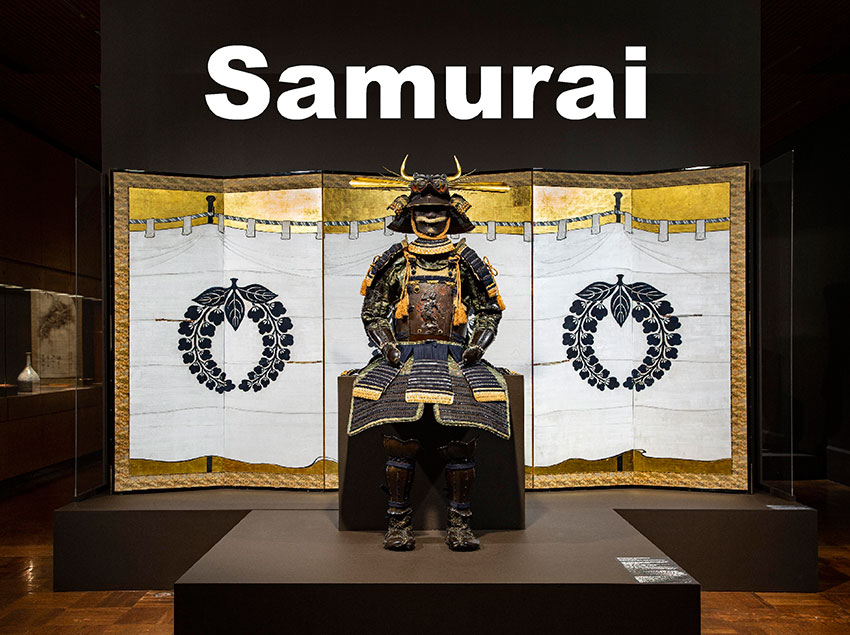
Installation view: Samurai featuring Military banner (jinmaku),
with falling wisteria crest by a Japanese artist and Samurai armour
Over 100 works of art from AGSA’s Japanese collection
that portray the pervasive influence of the samurai in Japan
from the 14th to 21st centuries
 Russell Kelty, curator of the Samurai exhibition, has written comments on the images that provide an exceptional understanding of the works.
Russell Kelty, curator of the Samurai exhibition, has written comments on the images that provide an exceptional understanding of the works.
‘The culture and identity of the samurai are often understood in one particular context: as ferocious and loyal warriors who lived by a strict moral code.’
‘Samurai seeks to redress this by presenting the complexities of their cultural influence and their transformation into a global phenomenon.’
SAMURAI WARFARE EQUIPMENT
Samurai armour
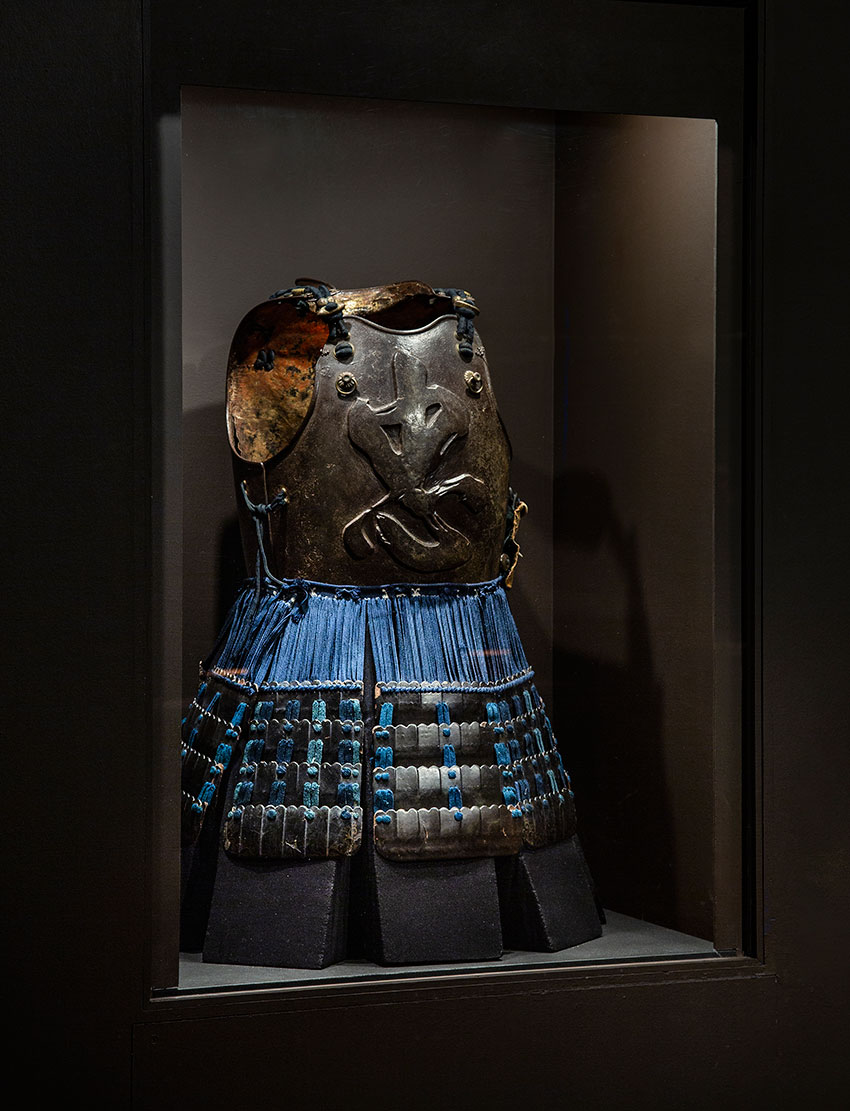
Installation view: Samurai featuring Cuirasse with characters for ‘loyalty’ by a Japanese artist,
Art Gallery of South Australia, Adelaide; photo: Saul Steed

Comments: ‘Armour was created during the Genroku era (1688–1704), often regarded as a ‘golden age’ in Japanese history, with a hundred years of peace having fostered an unprecedented blossoming in the arts. In this age of peace, armour was no longer an implement of war but instead worn during processions or displayed during auspicious times of the year and featured ingenious integration of locally and internationally sourced commodities, such as stencilled doe skin and silk’.
‘The embossed breastplate of the suit was created in 1699 by Myōchin Munesuke (1643−1735), a fifty-fourth generation metal-craftsmen and premier armour and sword expert who lived in downtown Edo. The refinement of the suit is contrasted by the wrathful depiction of Fudō Myōō, the Buddhist deity most often associated with samurai, and a frightful sculpture of a demon or shigami on the helmet, which was intended to strike fear in the opposition and endow the wearer with talismanic protection’.
Myōchin Munesuke, Samurai armour
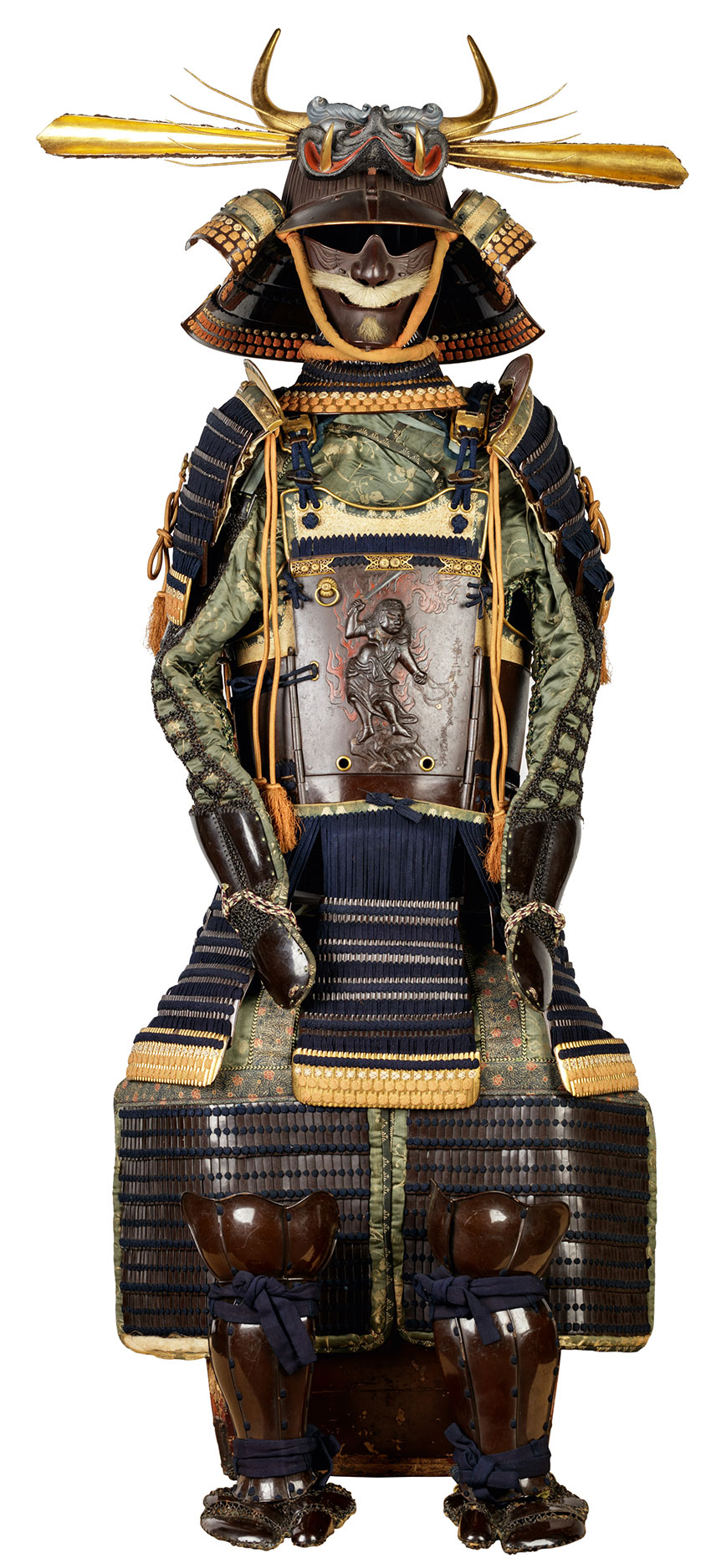
Myōchin Munesuke, 1688-1735, Samurai armour, with breastplate depicting Fudō-myōō and inscribed ‘A Fortuitous Day, the 8th month of the 12th year of Genroku (1699), Myochin Munesuke’, c.1699, Edo (Tokyo), iron, gilded, silvered and patinated copper, gold leaf, wood, silk, cotton, leather, animal fur.
Gift of Max Carter AO, Susan Cocks, John Crosby, Dr Peter Dobson, Sandra Dobson, Frances Gerard, Arata Gwinnett, Sam Hill-Smith, Shane Le Plastrier, Mark Livesey QC, Joan Lyons, Dr Leo Mahar, Skye McGregor, Diana McLaurin, John Thornton, Zena Winser and David C. Urry through the Art Gallery of South Australia Foundation Collectors Club 2016, Art Gallery of South Australia, Adelaide.
The sword

Comments: ‘The sword is often referred to as the ‘soul of the samurai’. During the largely peaceful Edo period (1615-1868) samurai were required to wear both ‘long’ and ‘short’ swords. Metal craftsmen catered to needs of the military elite and their spectacular creations were used in procession and for display’.
‘As a result, the smallest components of swords were intricately crafted to reflect the wearers status and cultural interests. The sword guard (tsuba) above, which entered the Art Gallery’s collection in 1916, displays a hare pounding rice on the moon to make mochi while the hilt collar (fuchi) and pommel (kashira) which display elegantly rendered calligraphy in inlaid gold’.
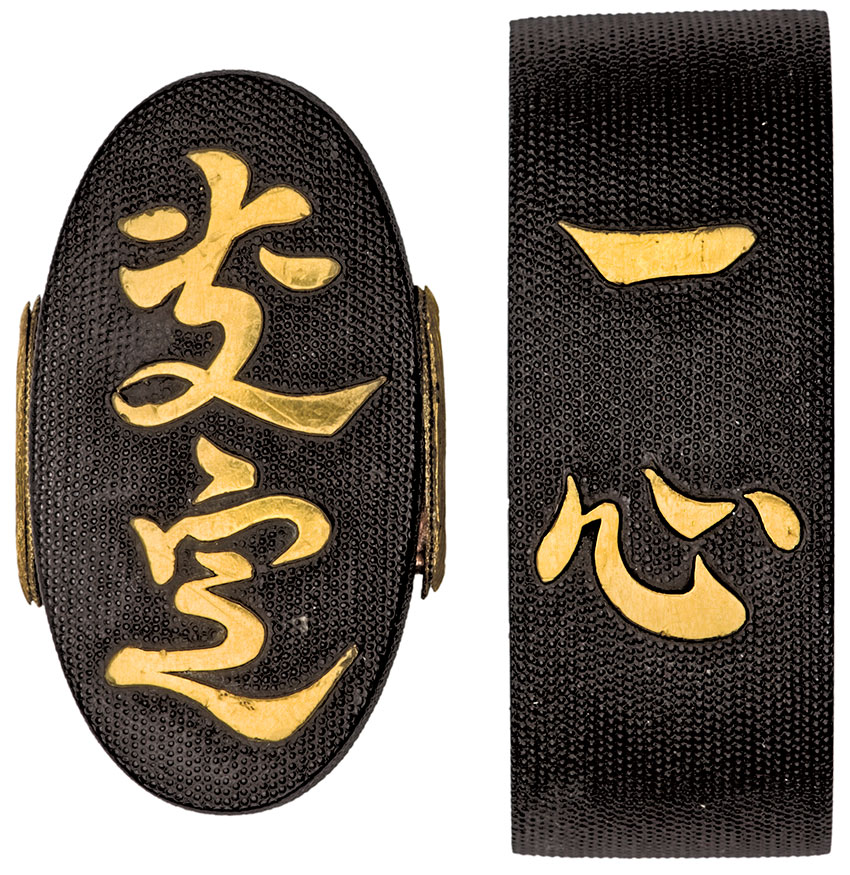
Sano Naoyoshi, Japan active 19th century, Fuchi-kashira set, fuchi: a family crest and calligraphy, ‘issin’, one heart; kashira, c.1830, Japan, iron, shakudo, gold. Gift of John and Geraldine Halls 1984, Art Gallery of South Australia, Adelaide.
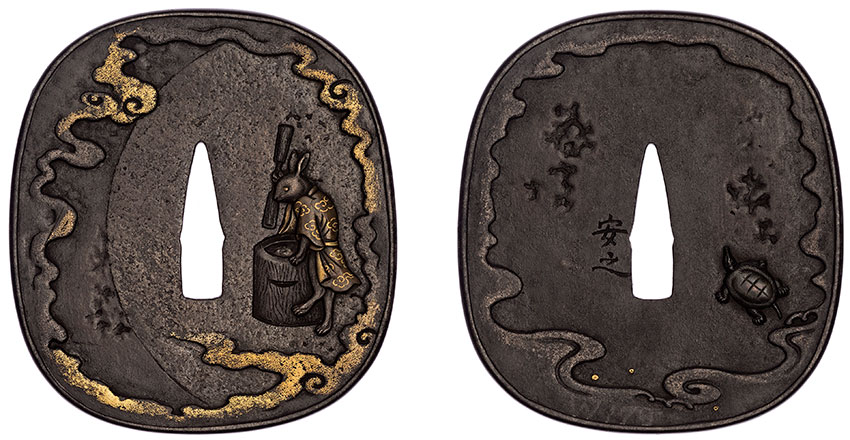
Yasuyuki, Japan, active early 18th century, Tsuba, ; hare in the moon, pounding rice; reverse: a tortoise near a river, early 18th century, Japan, iron, gold-copper alloy (shakudō), silver; Bequest of Sir Samuel Way 1916, Art Gallery of South Australia, Adelaide.
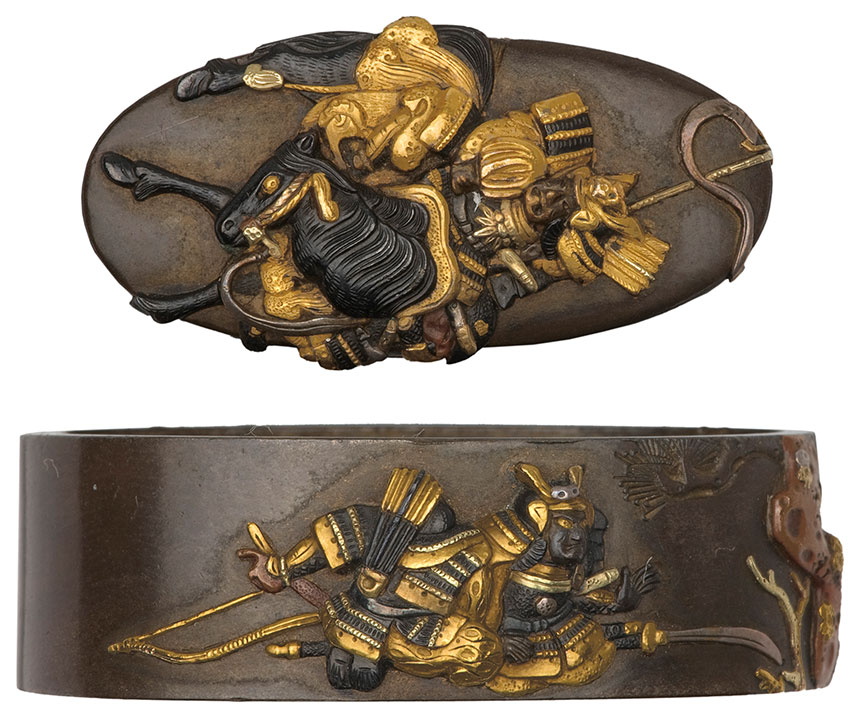 Yoshimasa, Fuchi-kashira set, fuchi: samurai on horseback carrying a standard; kashira; obverse: samurai on horseback; reverse: tent, lances and flag, c.1790, shibuichi, shakudo, gold, 3.4 cm (fuchi, length), 3.9 cm (kashira, length); Gift of John and Geraldine Halls 1984, Art Gallery of South Australia, Adelaide
Yoshimasa, Fuchi-kashira set, fuchi: samurai on horseback carrying a standard; kashira; obverse: samurai on horseback; reverse: tent, lances and flag, c.1790, shibuichi, shakudo, gold, 3.4 cm (fuchi, length), 3.9 cm (kashira, length); Gift of John and Geraldine Halls 1984, Art Gallery of South Australia, Adelaide
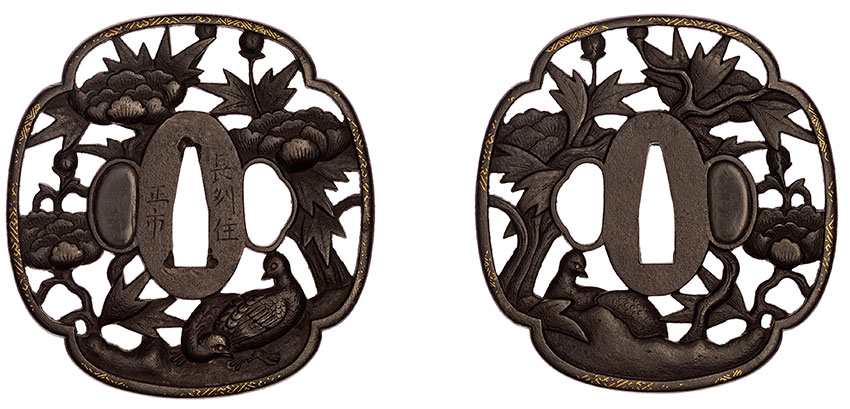
Yoshimasa, Fuchi-kashira set, fuchi: samurai on horseback carrying a standard; kashira; obverse: samurai on horseback; reverse: tent, lances and flag, c.1790, shibuichi, shakudo, gold, 3.4 cm (fuchi, length), 3.9 cm (kashira, length); Gift of John and Geraldine Halls 1984, Art Gallery of South Australia, Adelaide
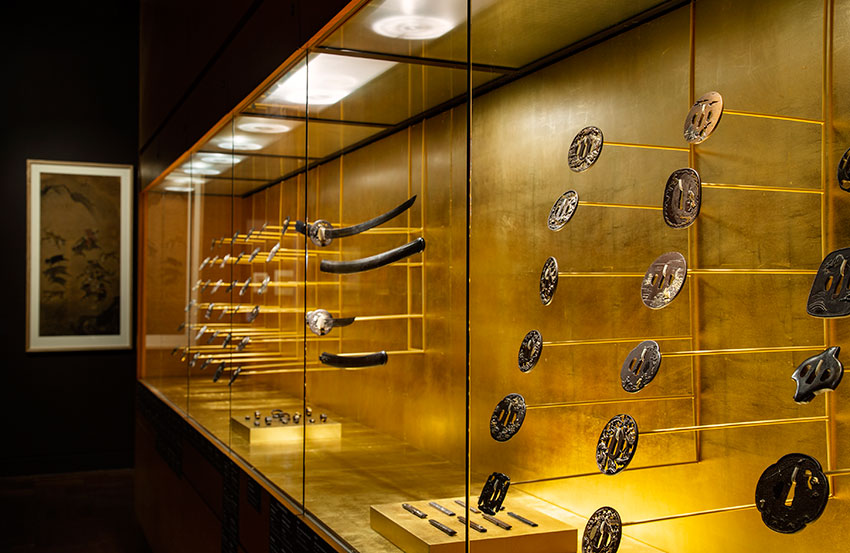 Installation view: Samurai, Art Gallery of South Australia, Adelaide; photo: Saul Steed
Installation view: Samurai, Art Gallery of South Australia, Adelaide; photo: Saul Steed
The Samurai Epic
Battle scenes from The tales of Heike
(Heike monogatari)
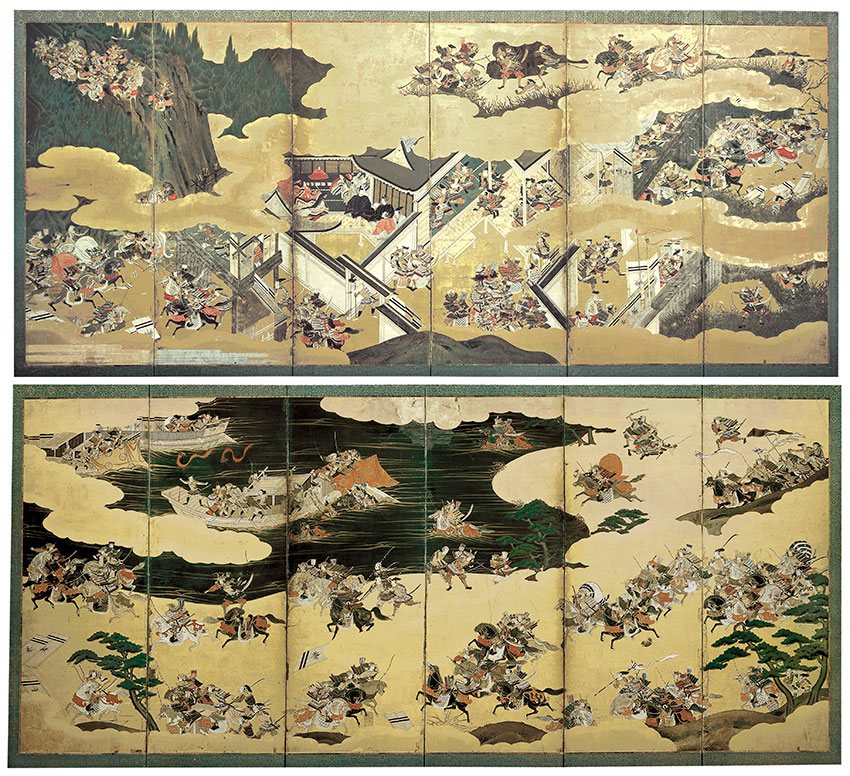
DETAIL: Japan, Battle scenes from The tales of Heike (Heike monogatari) early 18th century, pair of six-panel screens, colour and gold on paper; Gift of Andrew and Hiroko Gwinnett through the Art Gallery of South Australia Foundation 2003

Comments: ‘The Tales of Heike is the greatest military epic in Japanese literature and documents the rise and fall of the Heike (Taira) clan at the hands of their enemies, the Minamoto (Genji) clan, during the catastrophic Genpei wars (1180-1185). The stories were originally sung by wandering ‘lute priests’ and compiled around 1300, portray the transition from an era dominated by the aristocracy of the imperial court to the age of the samurai’.
‘During the peaceful Edo period (1615-1868) when these screens were created, the iconic moments of The Tales of the Heike appeared in a vast array of media for every level of society. Screens such as these were created for the military elite, who appreciated them for their beauty and illustration of idealized values of the samurai. According to historical accounts screens such as these were created for foreign embassies visiting Japan’.
Archery contest at Sanjūsangendō
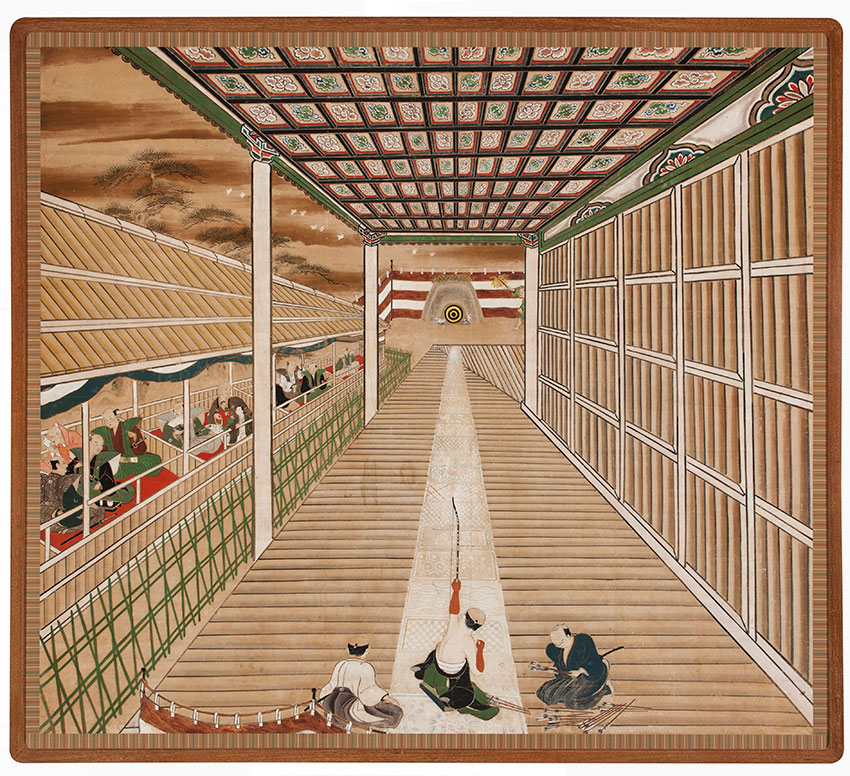
Japan, Archery contest at Sanjūsangendō (Sanjūsangendō tōshiya no zu), c.1750, Kyoto, tsuitate screen mounted on panel, opaque watercolour, ink and gold on paper; Gift of Frances Gerard and Mark Livesey QC with the assistance of the Roy and Marjory Edwards Bequest Fund through the Art Gallery of South Australia Foundation Collectors Club 2014, Art Gallery of South Australia, Adelaide
 Comments: ‘The annual archery contest held on the western veranda of the Sanjusangendō temple, in Kyoto, is known as the tōshiya, at which daimyo and their most proficient archers competed to achieve the highest percentage of arrows hitting the target. Contests such as the tōshiya were seen as way to revitalize the eroding status of the samurai class introduced by the shogun Tokugawa Yoshimune (1684-1751) in 1716 and were attended by a cross section of Kyoto society as depicted by the crowded stands to the left which include a Buddhist priests smoking and even a small child’.
Comments: ‘The annual archery contest held on the western veranda of the Sanjusangendō temple, in Kyoto, is known as the tōshiya, at which daimyo and their most proficient archers competed to achieve the highest percentage of arrows hitting the target. Contests such as the tōshiya were seen as way to revitalize the eroding status of the samurai class introduced by the shogun Tokugawa Yoshimune (1684-1751) in 1716 and were attended by a cross section of Kyoto society as depicted by the crowded stands to the left which include a Buddhist priests smoking and even a small child’.
‘During the mid-18th century prints depicted the myriad of festivities on offer during this contest as well as the depth, by using the European convention of one point perspective by focusing on the path of the arrow, which is emphasized by the imported Indian textiles (sarasa). The Portuguese and the Dutch introduced European techniques of painting, such as perspective, which was integrated by Japanese painters and woodblock print artists during the 18th century and known as ‘floating’ or ‘sunken’ pictures’.
Sasai Kyuzo Masayasu
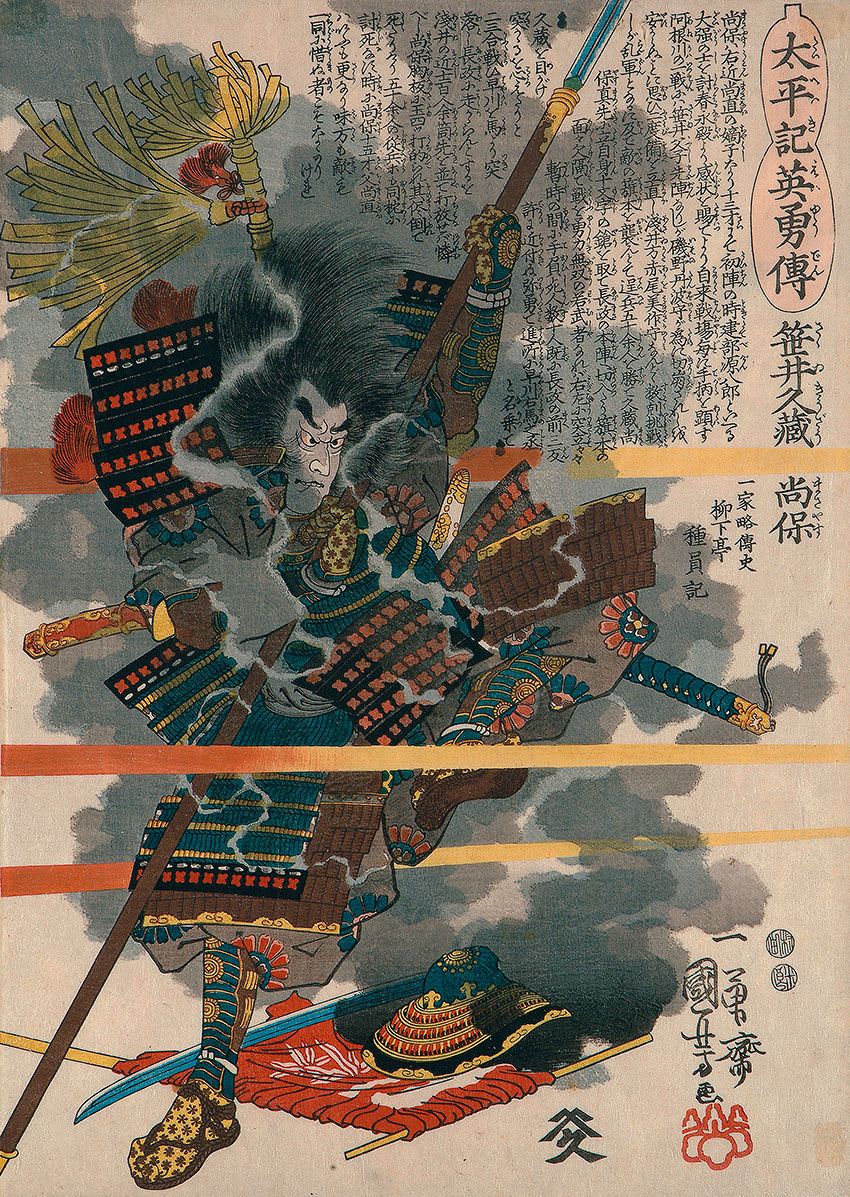
Kuniyoshi Utagawa, Japan, 1798 – 1861, Sasai Kyuzo Masayasu, from the series Heroic stories of the Taiheiki (Taiheiki eiyuden), c.1847-50, Edo (Tokyo), woodblock print, ink and colour on paper; Gift of Brian and Barbara Crisp in memory of their son Andrew 2005, Art Gallery of South Australia, Adelaide.
Miyamoto Musashi
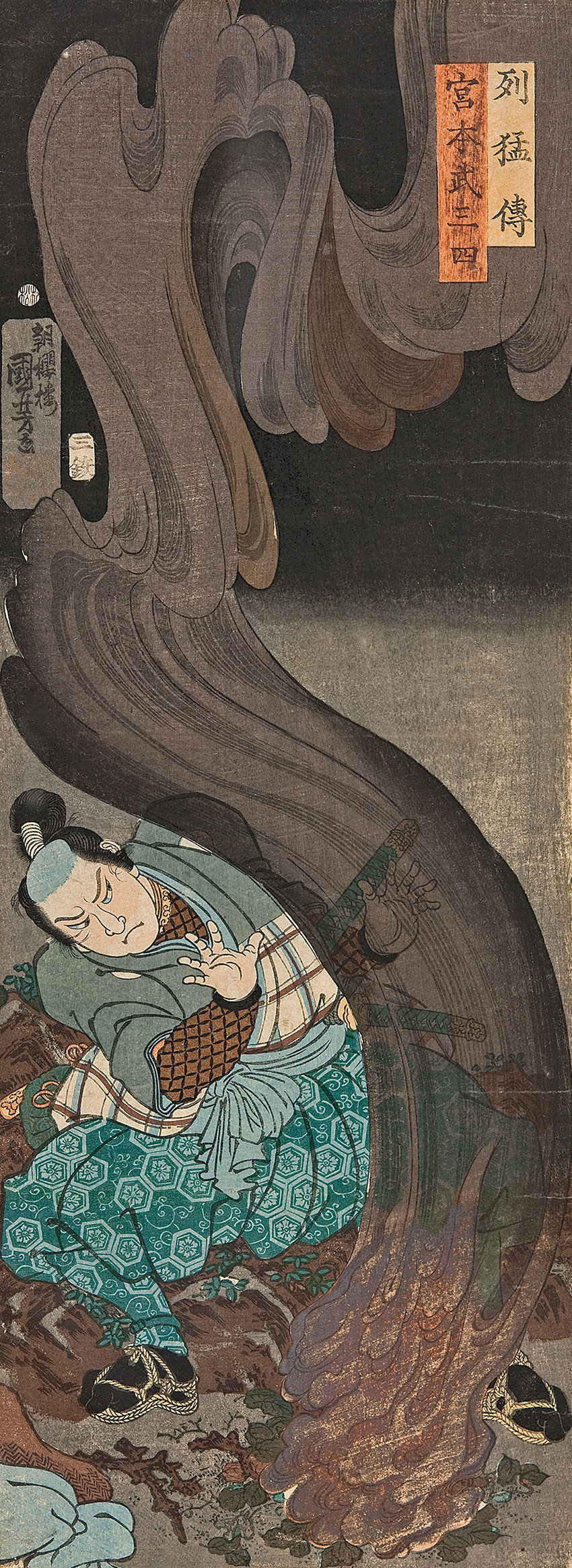
Utagawa Kuniyoshi, Japan, 1798 – 1861, Miyamoto Musashi, from the series Tales of fierce warriors (Retsumoden), c.1844-46 (1856), Edo (Tokyo) Woodblock print, ink and colour on paper, 49.2 x 18.3 cm (image & sheet). Gift of Brian and Barbara Crisp in memory of their son Andrew 2005. Art Gallery of South Australia, Adelaide.
Resting under a cherry tree
(Taira no Tadanori, 1144–1184 )

Kiyochika Kobayashi, Japan, 1847 – 1915, Taira no Tadanori (1144–1184) resting under a cherry tree, 1884 (Meiji 17), Tokyo, woodblock print, ink and colour on paper, triptych; d’Auvergne Boxall Bequest Fund 2013, Art Gallery of South Australia, Adelaide, photo: Stewart Adams.
Details of Resting under a cherry tree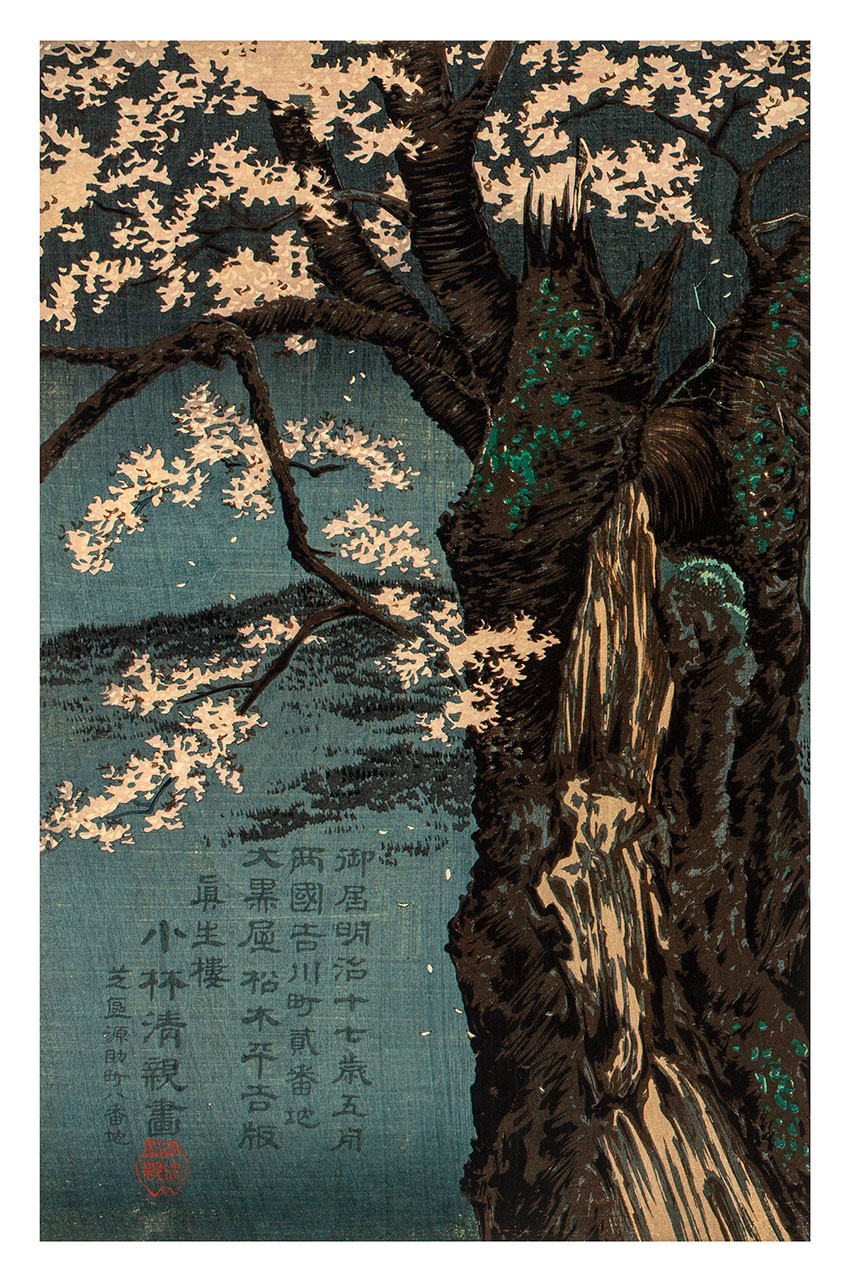
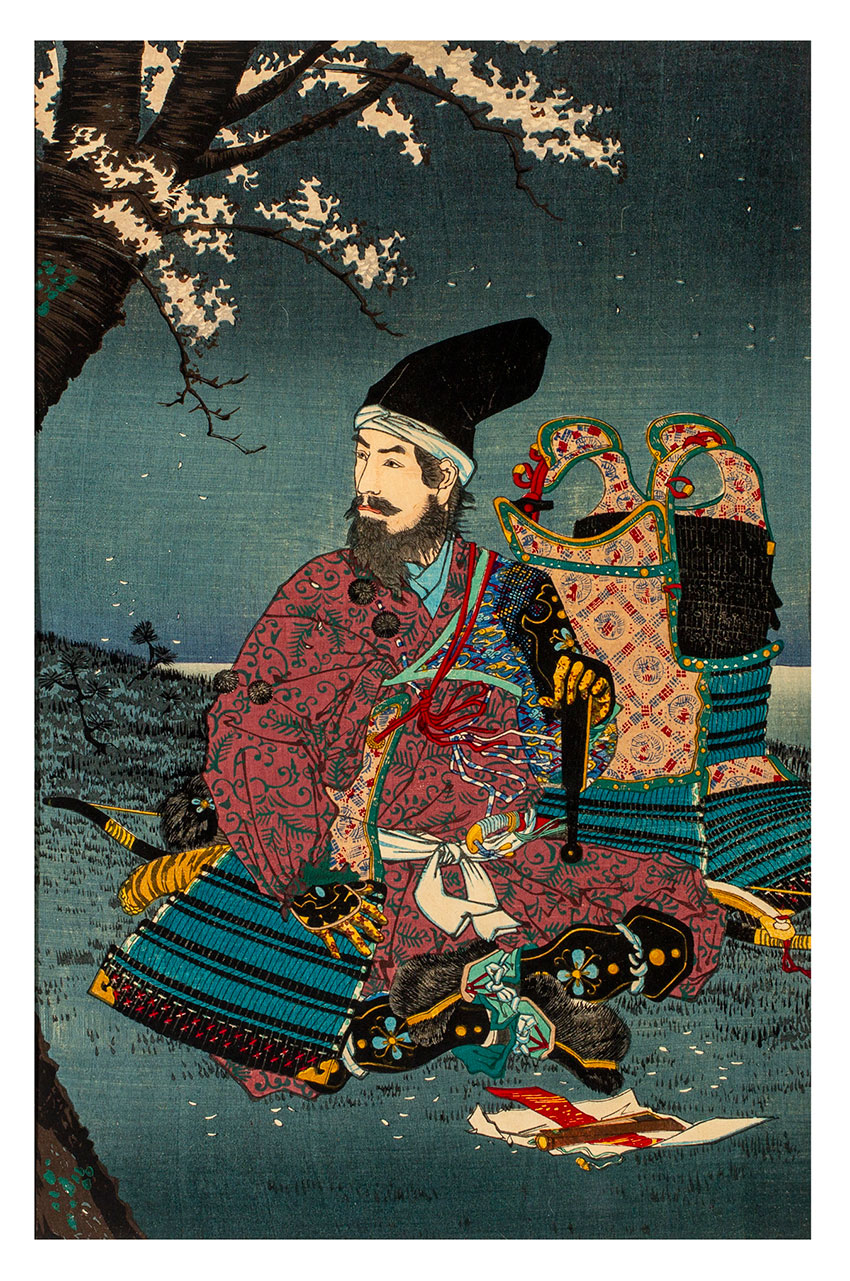
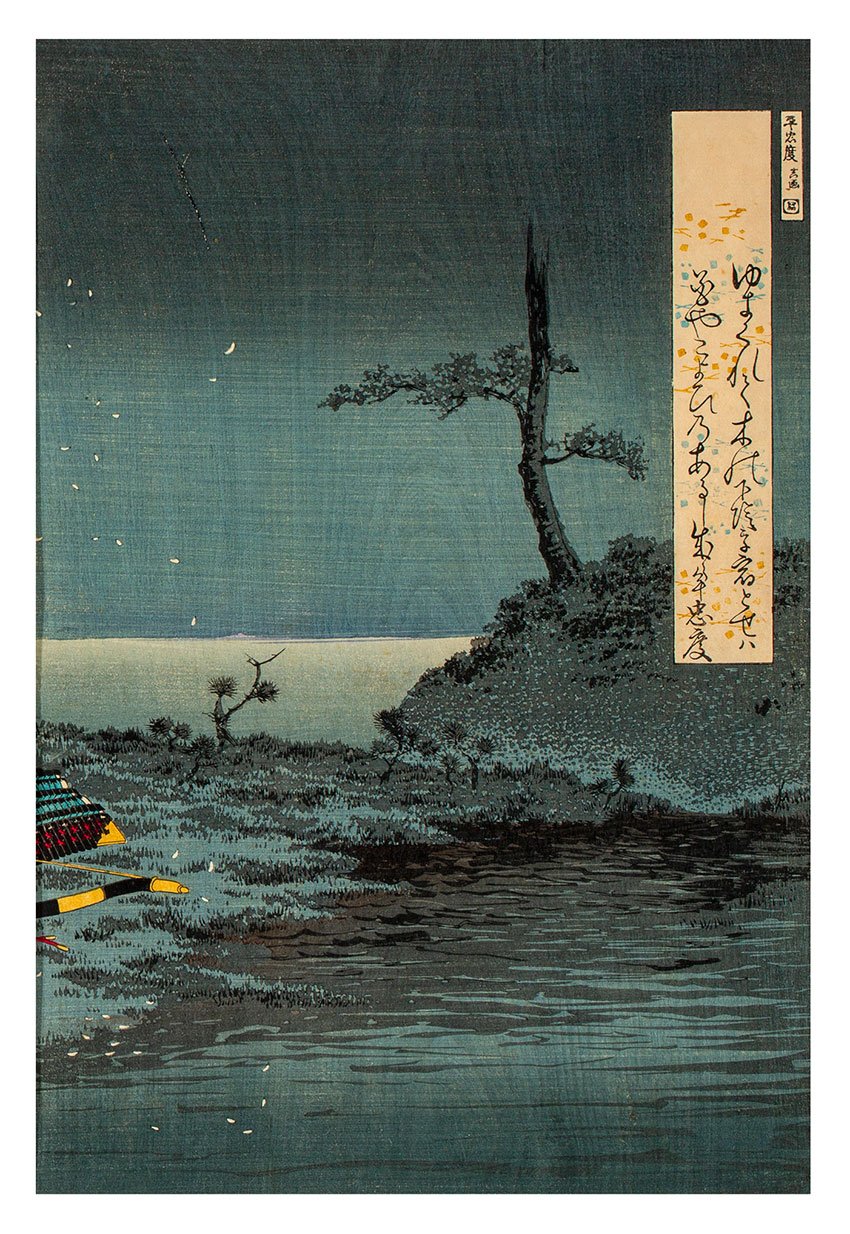
Deities
Zaō Gongen

Jakugen, Japan, active early 18th century, Zaō Gongen, 1704, Edo (Tokyo), wood, inlaid glass, traces of colour; Gift of Andrew and Hiroko Gwinnett through the Art Gallery of South Australia Foundation 2007, Art Gallery of South Australia, Adelaide.

Comments: ‘Throughout Asia, particular regions and mountains evoke a potent spirituality and remain the abode of a deities associated with both Buddhist and indigenous beliefs. To adherents devoted to aesthetic practices at Mt Kinpu, south of Nara, the mountain ascetic En no Gyōja (b. 634-700/707), the founder of the Shugendō cult which combines Taoism, Shinto, esoteric Buddhist and shamanistic beliefs and practices, was performing a hundred day retreat on Mt Kinpu when the historical Buddha revealed himself in the form of Zaō Gongen’.
‘This rare sculpture of the wrathful Zaō Gongen was created in 1704 in the capital of Edo (present day Tokyo) as indicated by the inscription on the interior of the torso. It depicts the Buddha manifesting in the form of a local Shinto kami on a rocky precipice and embodies the fiery energy that removes obstacles to the spiritual path’.
‘This sculpture conforms to aesthetic ideals established in the Kamakura period (1185-1333) which emphasized a vigorous and expressive realism evoked through life like facial expressions and realistic drapery’.
Fudõ Myõõ
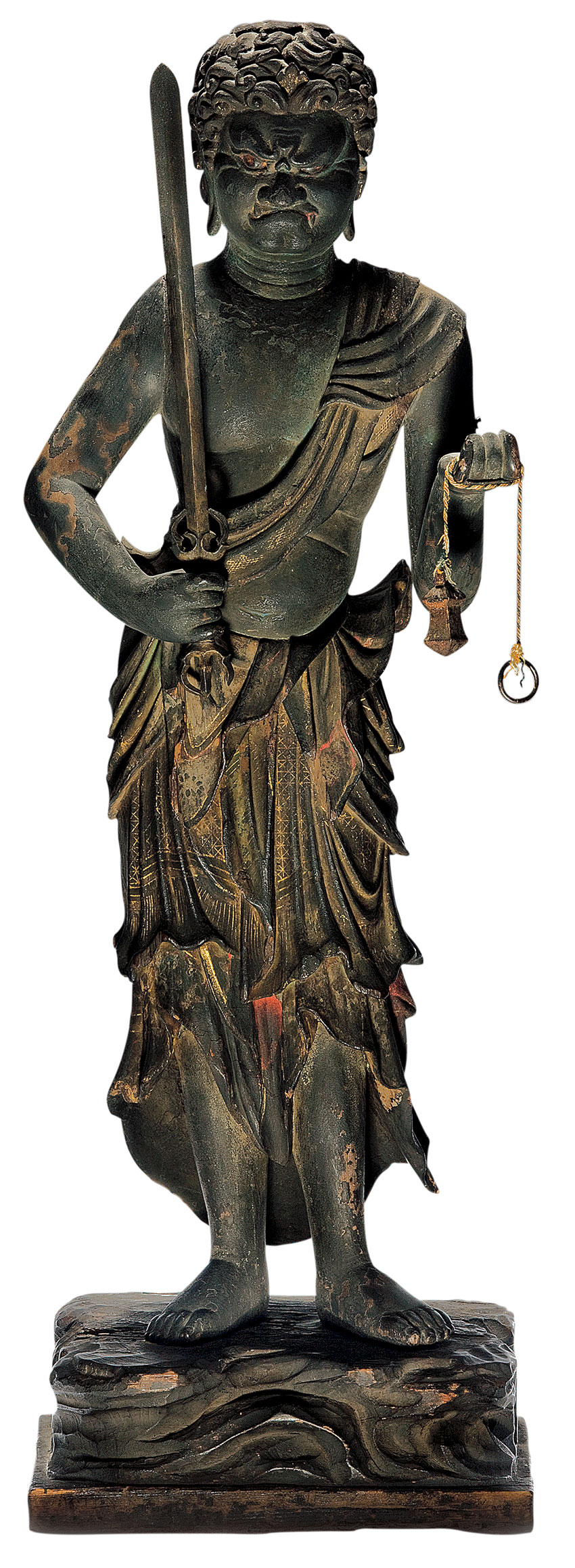
Japan, Fudõ Myõõ, 14th-15th century, Japan, wood, traces of colour and gilding, brass, cotton; M.J.M. Carter AO Collection through the Art Gallery of South Australia Foundation 2017, Art Gallery of South Australia, Adelaide.
The Theatre
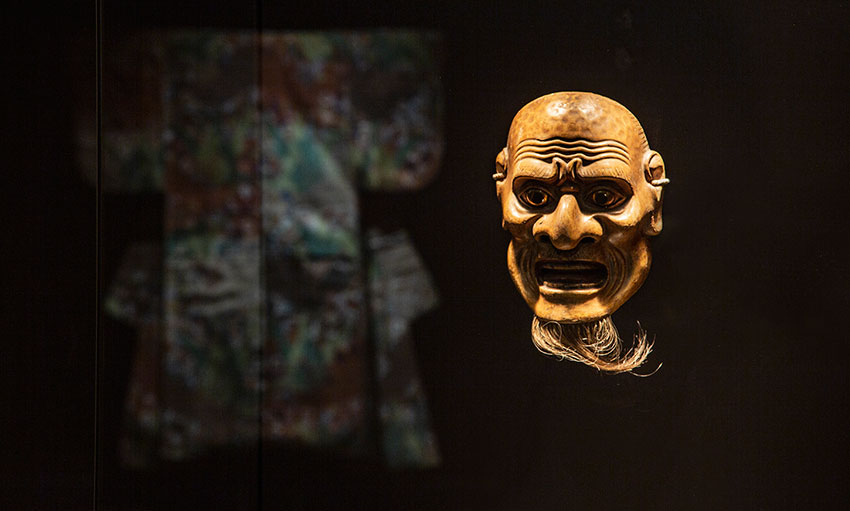 Installation view: Samurai featuring No mask of Washibana akujo by a Japanese artist,
Installation view: Samurai featuring No mask of Washibana akujo by a Japanese artist,
Art Gallery of South Australia, Adelaide; photo: Saul Steed
Kabuki actor Okochi Denjiro as Tange Sazen
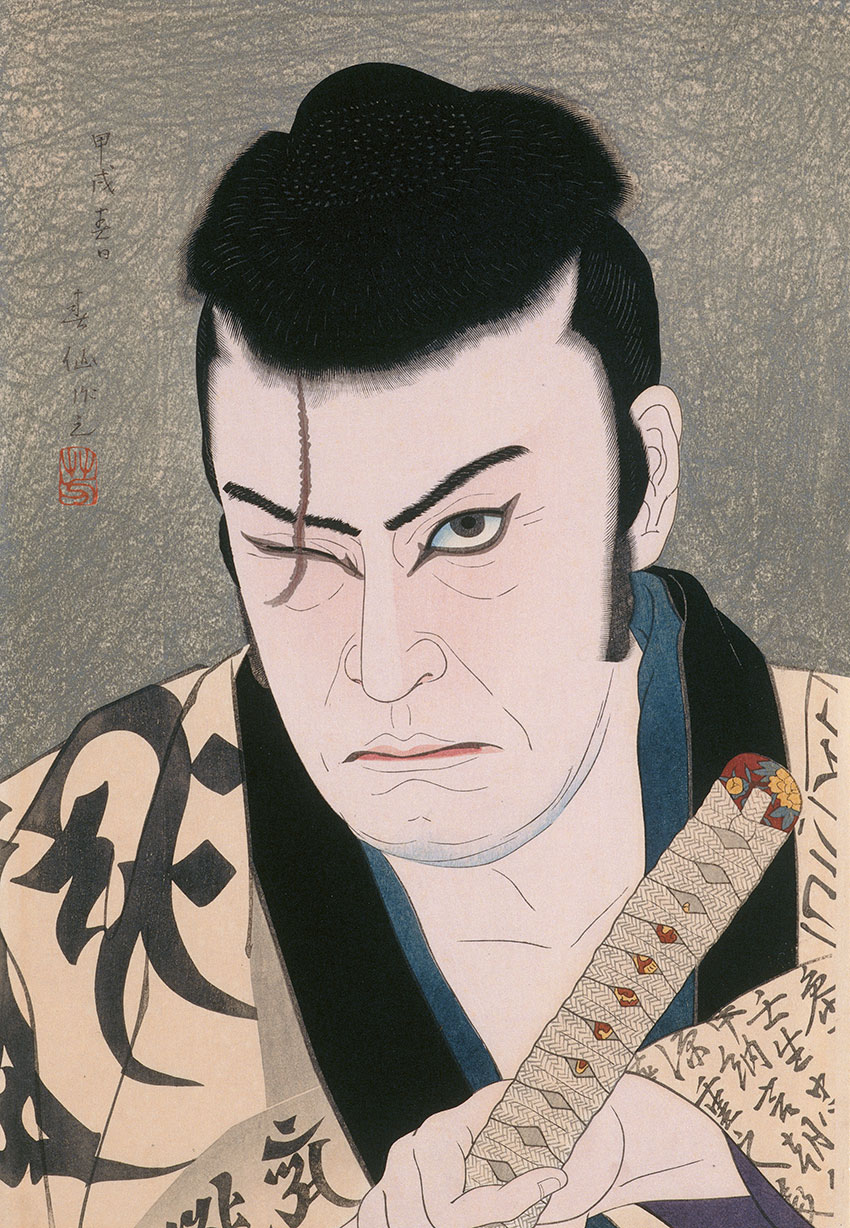
Natori Shunsen, Japan, 1886 – 1960, Okochi Denjiro as Tange Sazen, 1931 or 1934 (original series 1931), Tokyo, woodblock print, ink and colour on paper; Gift of Brian and Barbara Crisp in memory of their son Andrew 2005, Art Gallery of South Australia, Adelaide.

Comments: ‘This print depicts the fictional, one-eyed, one-armed samurai Tange Sazen, played by the Kabuki and film actor Denjirō Ōkōchi (1898-1962). During the 1920s the character Tange Sazen appeared in serial stories in newspapers, early films and ultimately television’.
‘Shunsen is considered by many to be the last master of the Kabuki actor print (yakusha-e) the aesthetic of which was transformed by the rapid modernization in Japan during the late 19th and early 20th centuries. As a young man he moved to Tokyo and developed an interest in Kabuki actor prints while working as an illustrator for the newspaper Asahi Shimbun’.
Kabuki actor Nakamura Utaemon IV as Kumagaya Jiro Naozane
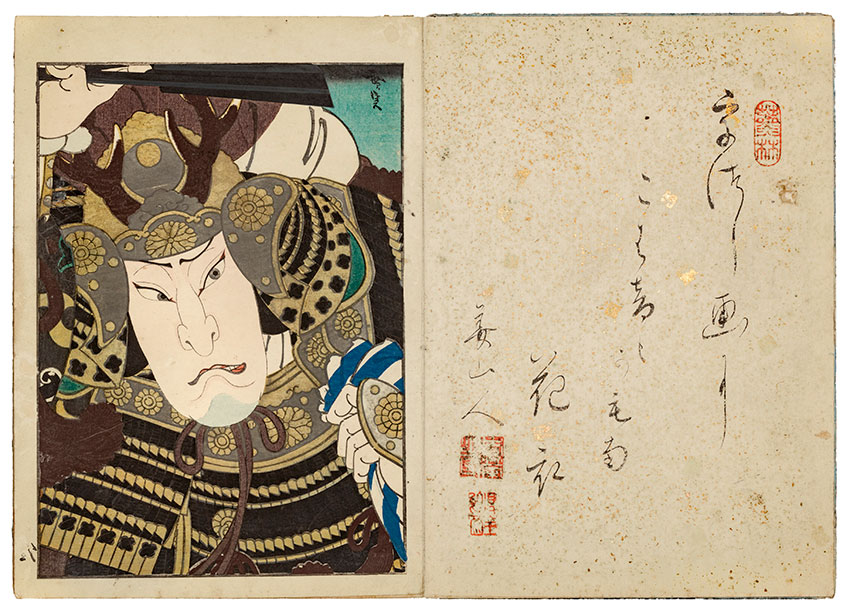
Gosotei Hirosada, Japan, died 1865, The kabuki actor Nakamura Utaemon IV as Kumagaya Jiro Naozane, album of colour woodblock actor prints, 25.0 x 19.0 cm: Elizabeth and Tom Hunter Fund 2008.
No costume

Japan, No costume, with autumn grasses design, 1910-20, Japan, silk, metallic thread, natural and synthetic dyes, resist dye and supplementary weft brocade, 158.0 cm (hem to collar), 133.0 cm (sleeve to sleeve); Gift of Andrew and Hiroko Gwinnett through the Art Gallery of South Australia Foundation 2008, Art Gallery of South Australia, Adelaide.
Traditional dress
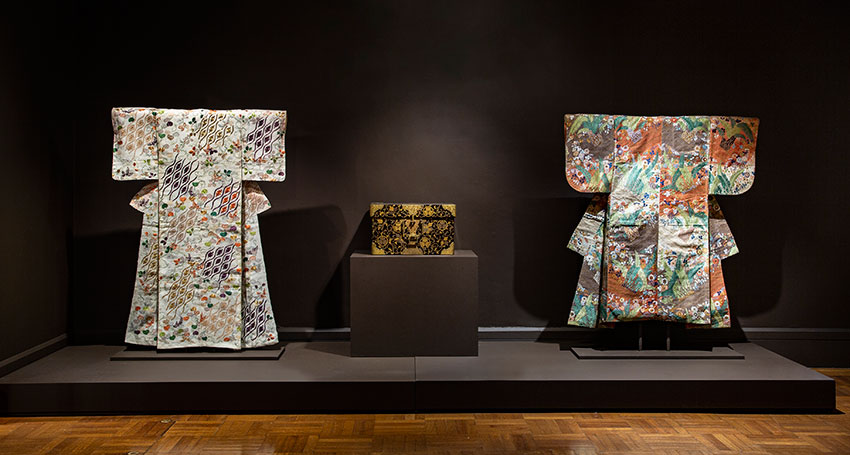 Installation view: Samurai, Art Gallery of South Australia, Adelaide; photo: Saul Steed
Installation view: Samurai, Art Gallery of South Australia, Adelaide; photo: Saul Steed
Summer robe
Katabira. Front

Japan, Summer robe (katabira), with hollyhock, chrysanthemum and ‘rising steam’ motifs, c.1780, Edo (Tokyo), plain weave ramie, ink painting, stencil imitation tie-dyeing, embroidery in silk, gold-wrapped thread; Gift of Joan Beer in memory of her husband Colin through the Art Gallery of South Australia Foundation Collectors Club 2019, Art Gallery of South Australia.
Katabira back
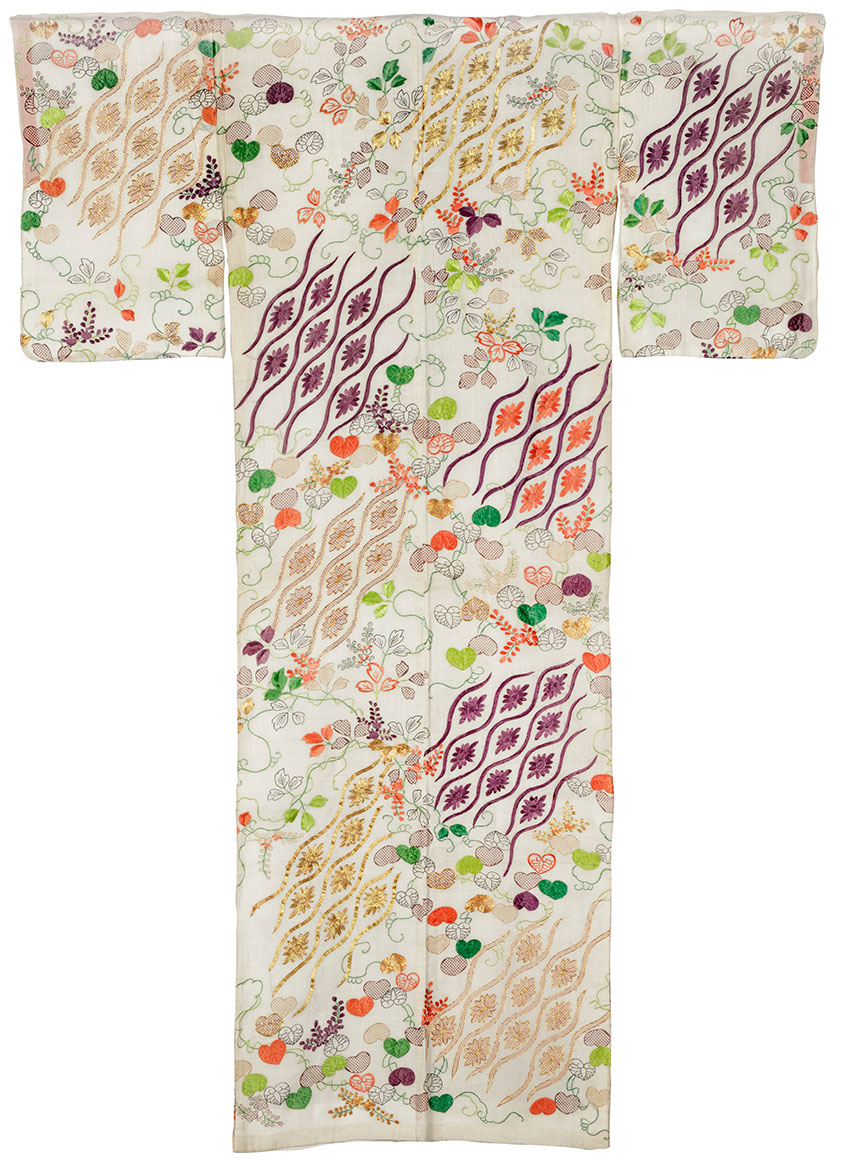

Comments: ‘The term katabira refers to an unlined garment created from light fabric and worn as an outer layer over other robes during the summer months. The sheer white ground of Summer robe was made from the baste fibres of a nettle or hemp plant and allowed the wearer respite from the heat and the humidity of summer. It displays motifs reserved for women in the households of prominent daimyo and the shogun, which would have been readily recognizable at the time’.
‘Summer robe was created in the late eighteenth century for a high-ranking woman in a samurai family and evokes the most prized aesthetic ideals of the military aristocracy – a subtle balance between extravagance and restraint. It is elegantly decorated with a profusion of floral motifs, created using naturally dyed and gold-wrapped silk, embroidery and paste resist and stencil techniques’.
Screens and Scrolls
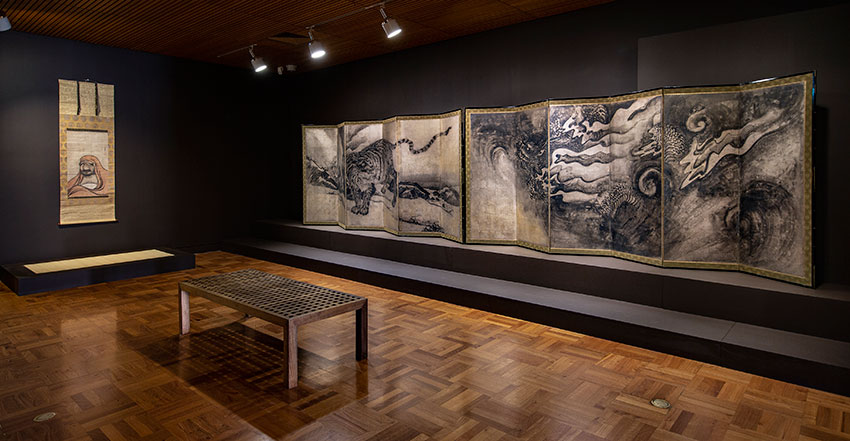 Installation view: Samurai featuring Portrait of Daruma by Unkoku Tōgan and Dragon
Installation view: Samurai featuring Portrait of Daruma by Unkoku Tōgan and Dragon
and Tiger by a Japanese artist, Art Gallery of South Australia, Adelaide; photo: Saul Steed
Birds, tree and flowers
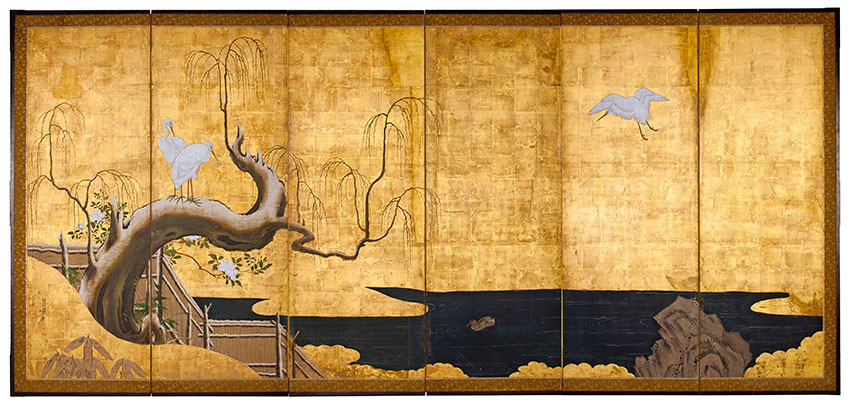
Kanō Sanraku, Japan, 1559 – 1635, Birds, tree and flowers, 1619-35, Kyoto, Japan, six panel screen, ink, colour and gold on paper; Gift of Andrew and Hiroko Gwinnett through the Art Gallery of South Australia Foundation 2015. Donated through the Australian Government’s Cultural Gifts Program, Art Gallery of South Australia, Adelaide.

Comments: ‘This single screen was once part of a pair, and depicts the transition from Winter to Spring, as represented by the flower buds of the ancient willow tree arching over the bamboo fence and the blossoming flowers. The body of water is shrouded in a golden mist as a white heron lands and a duck swims in the water next to a Daoist-looking rock. Paintings of the four seasons (shiki-e) became popular during the nineth and tenth centuries with the burgeoning of Japanese-style poetry, waka, which conveyed mood and emotion through seasonal imagery of flora and fauna’.
‘Active from the fifteenth to the mid-nineteenth centuries, the Kanō school remains the longest continuous painting lineage in the world. Artists of the school developed a signature style, melding brush-and-ink painting with vivid colours on cut gold to decorate the grand castles and mansions of the military elite. Sanraku was the head of the Kyoto branch of the Kanō school; his talents were first observed by the warlord Toyotomi Hideyoshi (1536–1598) when Sanraku drew a horse in the sand, following which he was adopted by the artist Kanō Sansetsu (1589–1651)’.
Detail of Birds, tree and flowers
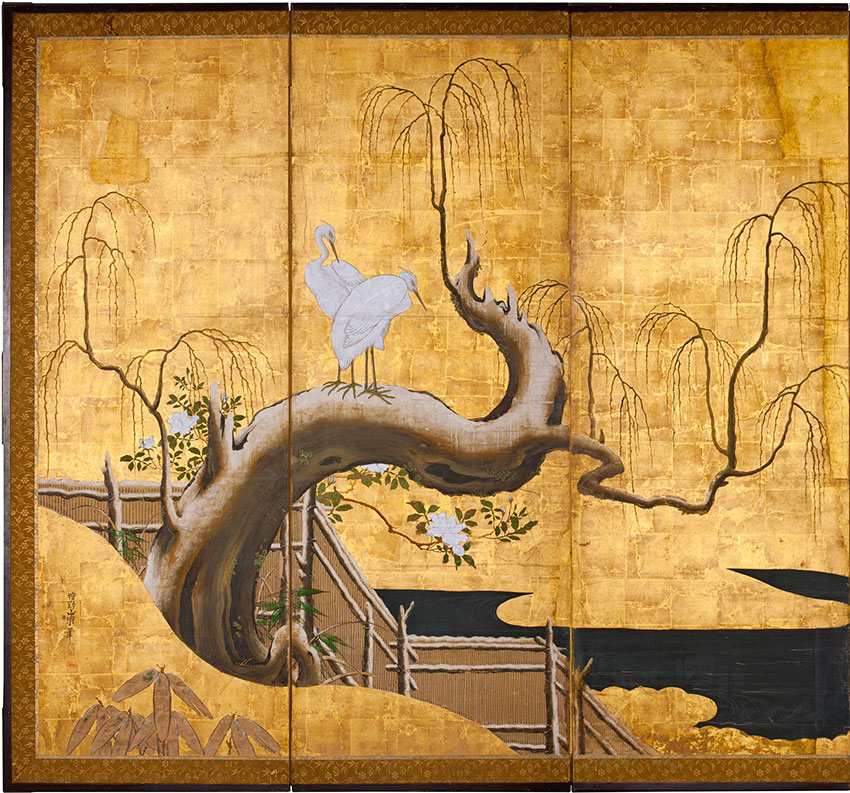
Deep valley, old pine

Yamamoto Baiitsu, Japan, 1783 – 1856, Deep valley, old pine, c.1840s, Kyoto or Nagoya, ink on silk; Gift of Max Carter AO through the Art Gallery of South Australia Foundation 2017, Art Gallery of South Australia, Adelaide, photo: Richard P. Goodbody Inc.

Comments: ‘Deep valley and old pine presents the classic motif of hawk and pine re-envisioned by one of the most accomplished brush and ink painters of the late Edo period (1615–1868), Yamamoto Baiitsu. In Deep valley, the stoic hawk, a symbol of forbearance and endurance, as well as a highly prized commodity, grips a writhing pine branch as a waterfall cascades below which demonstrates a mastery of dry-brush techniques and various tonalities or ‘colours’ of ink’.
‘Throughout his life Baiitsu’s brush and ink paintings were highly sought after by the military elite and wealthy merchants in Nagoya and Kyoto. The significant size of the scroll would have required a large display space, known as a tokonoma, suggesting that Baiitsu created this for a patron of significant status’.
Dragon and bamboo after Sesshū Tōyō

Kanō Tan’yu, Japan 1602 – 1674, Dragon and bamboo after Sesshū Tōyō (1420-1506)c.1625, Edo (Tokyo), hanging scroll, ink on paper. Gift of Shane Le Plastrier through the Art Gallery of South Australia Foundation 2018, Art Gallery of South Australia, Adelaide.

Comments: ‘Dragon and bamboo was created by the foremost painter of the period, Kanō Tan’yu, who was appointed as the official artist for the Tokugawa shogunate in 1615. The hanging scroll was created not long after Tan’yu’s relocation from Kyoto to Edo, and its significant size indicates that it was intended for a patron of importance and stature’.
‘In this dynamic performance of brushwork, Kanō Tan’yu captures the moment the head and claw of a dragon emerge from the whorls of rain-laden clouds. The ‘wetness’ of the moment is emphasized by the use of a watery ink and controlled splashes. The poem below captures the majesty of the dragon and its connections to the natural world’:
rising out of the clouds,
dragons run and fly on the ground,
mountains and rivers.
Paintings
Collection of paintings by Sesson Shūkei
(Sesson gajō)
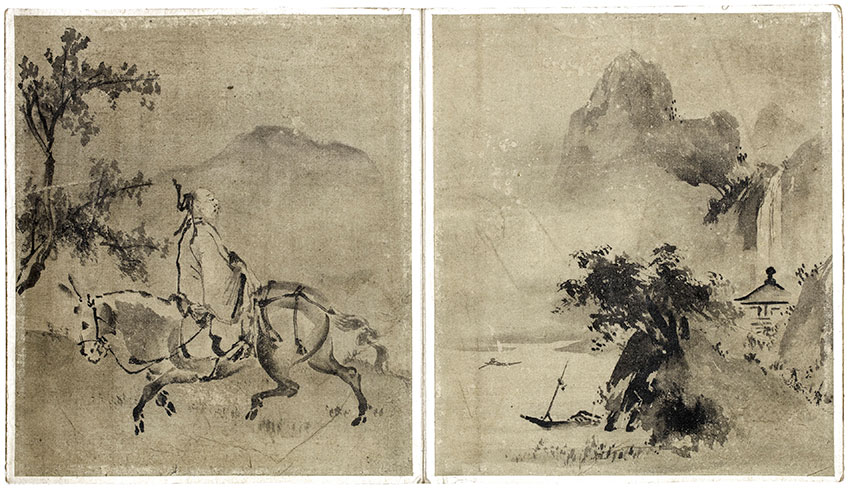
Sesson Shūkei, Japan, c.1492 / 1504 – 1589, Collection of paintings by Sesson (Sesson gajō), c.1550, compiled 18th century, bound album of 22 paintings, ink, gold on paper; silk, metallic thread, natural and resist dyes and supplementary weft brocade; Gift of Raphy Star through the Art Gallery of South Australia Foundation 2017. Donated through the Australian Government’s Cultural Gifts Program, Art Gallery of South Australia, Adelaide.
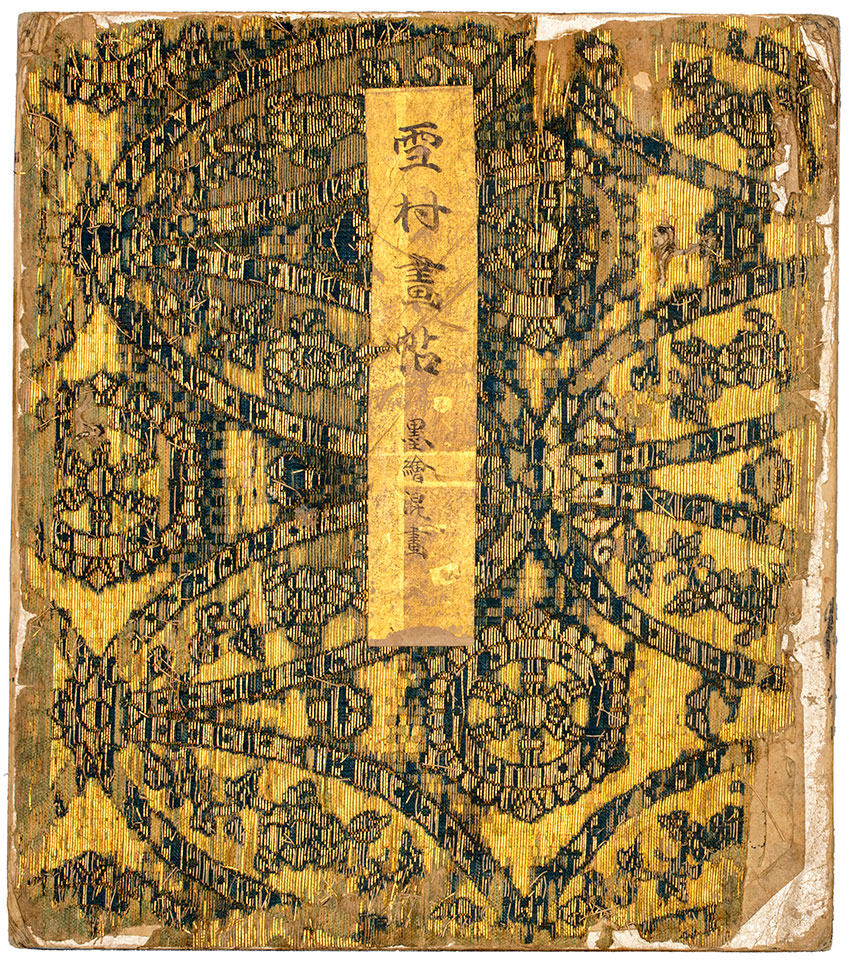

Comments: ‘This lavishily embellished album includes twenty-two brush and ink paintings by the artist Sesson Shūkei, who is considered the last great brush and ink painter of the Muromachi period (1392-1573). His life is largely shrouded in mystery due to his birth outside the cultural epicenter of Kyoto during a period of considerable turmoil. At an early age he entered a Zen temple to train as a painter and subsequently travelled throughout the Kanto region to study the great repositories of Chinese and Japanese brush and ink painting’.
‘Collection of paintings displays a diverse selection of themes and techniques which reflects the Zen Buddhist aesthetic of the period. Sesson’s depictions of flora and fauna display a subtle elegance which contrasts the power evoked in portraits of Daoist and Buddhist patriarchs. It is the novel interpretations of Chinese landscape paintings inhabited by diminutive travelers, pavilions and pagodas which are easily identified for their splashed ink and lack of depth. Sesson’s landscapes resonate with artists such as Tenshō Shūbun (1414-1463) and Sesshū Tōyō (1420-1506) from whom he derived his name’.
‘While Sesson did not sign his works until later in his life the album includes inscriptions by well-known Kanō school painters, Kanō Tsunenobu (1613-1713) and Kanō Isen’in Naganobu (1775-1828), which identify the artist as Sesson. Members of the Kanō school were painters for the elite of Japanese society as well as connisseurs of the history of painting. It is assumed that this album was once a treasured heirloom which was opened on auspicious occasions as inspiration or simply to admire a master painter.
Lacquer and Design
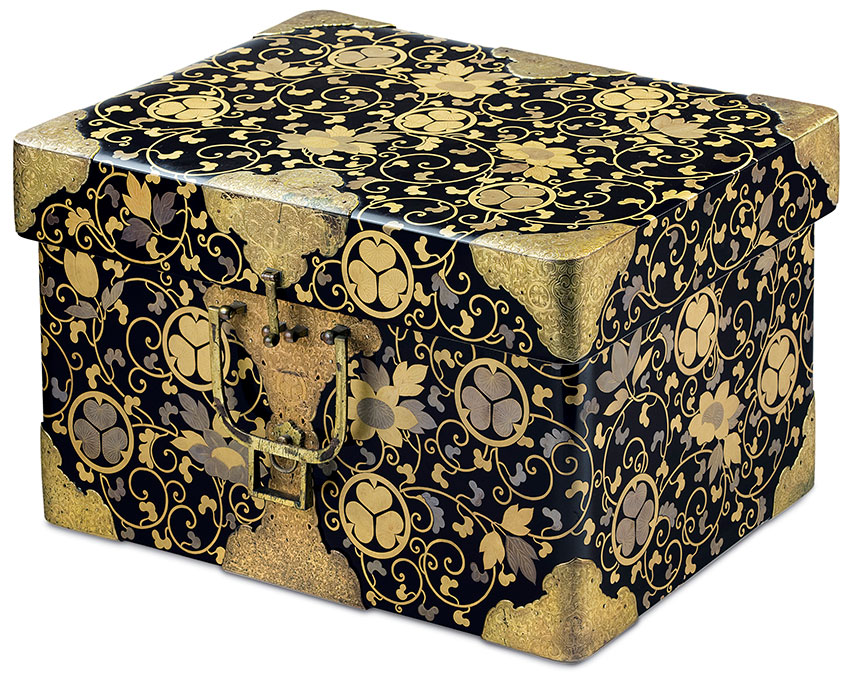
Japan, Portable storage chest (hasamibako], 18th century, Japan, wood, lacquer, gold leaf, metal, embossed paper; Gift of Andrew and Hiroko Gwinnett through the Art Gallery of South Australia Foundation 2011 in recognition of Dick Richards as the first Curator of Asian Art (1968-2000), Art Gallery of South Australia, Adelaide.

Comments: ‘Portable storage chest was created in the official lacquer studios of the Tokugawa shogunate: the three-leaf hollyhock crest appearing in its decoration was the exclusive possession of the ruling family. During the eighteenth century, there were also strict regulatory laws forbidding the use of gold-decorated items by any persons except the elite classes’.
‘The elegant restraint exhibited in the pristine quality of the sprinkled gold decoration (hiramaki-e), depicted on black lacquer, and the delicacy of the engraved metal fittings are evidence that it was used sparingly to transport clothing and other goods on auspicious occasions. The artist has cleverly created the bold design of plant scrolls (hanakusa) to attract the attention of a passing spectator rather than the minutely detailed decoration applied to lacquerwares intended for intimate domestic settings’.
Pottery
Tea Bowl
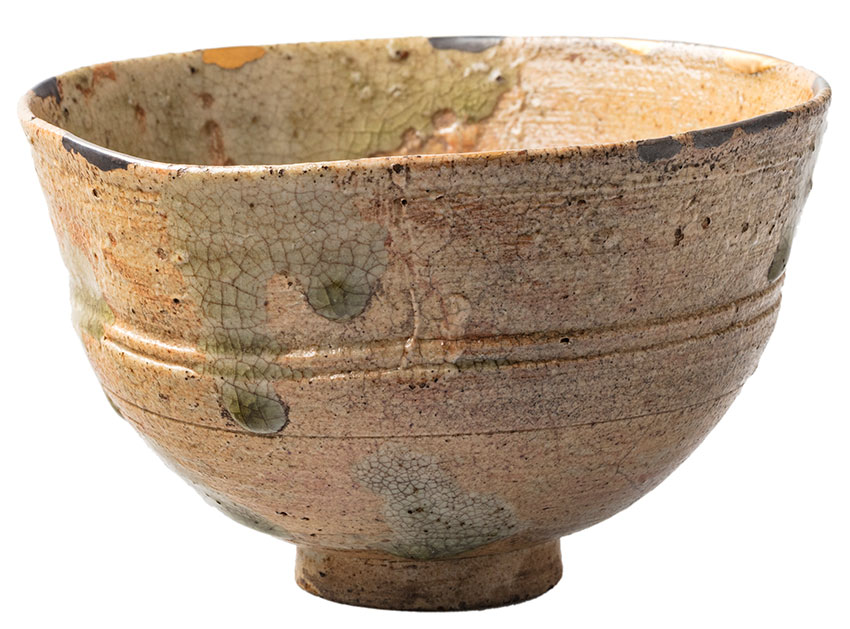
Japan, Tea bowl (chawan) named Morning Light (Akebono), 17th Century, Shigaraki, Shiga prefecture, earthenware, ash glaze, gold, silver mends, 8.0 x 13.0 cm (diam.); M.J.M. Carter AO Collection through the Art Gallery of South Australia Foundation 2019, Art Gallery of South Australia, Adelaide.

Comments: ‘Teabowl was once considered such a beautiful work of art that it was given the name ‘Morning light’ and when it was chipped previous owners painstakingly repaired it with gold and silver. As a result, it evokes the prevalent artistic concepts of the period, an appreciation for that which has acquired a ‘patina of age’.
‘The military elite were not simply warriors but often great connoisseurs’.
Statement
 AGSA Director Rhana Devenport ONZM, says, ‘This exhibition honours the prevailing cultural impact of the samurai as both masters of art and war and heralds AGSA’s longstanding commitment to representing the fertile and influential cultural histories of Japanese art.’
AGSA Director Rhana Devenport ONZM, says, ‘This exhibition honours the prevailing cultural impact of the samurai as both masters of art and war and heralds AGSA’s longstanding commitment to representing the fertile and influential cultural histories of Japanese art.’
Portraits of Rhana Devenport and Russell Kelty by Saul Steed
Art Gallery of South Australia
https://www.agsa.sa.gov.au/
North Terrace Adelaide SA 5000
T +61 8 8207 7000
E [email protected]